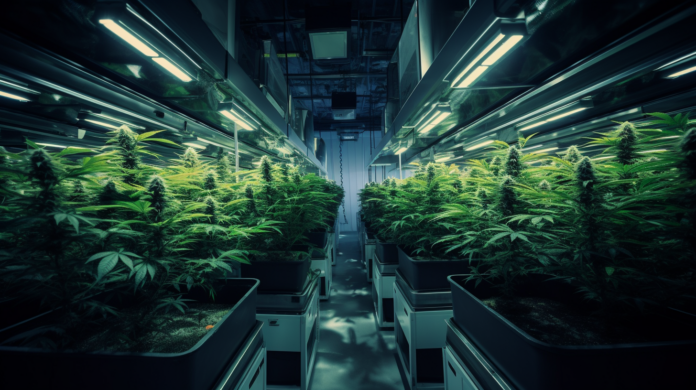Cultivation is evolving rapidly, driven by the need for sustainability, efficiency, and profitability in an increasingly competitive market. As cultivators face mounting pressure to improve their bottom lines, innovation has become the key to thriving in a rapidly changing environment. Looking forward to 2025, several game-changing trends are set to take center stage, with the potential to redefine the future of cannabis cultivation.
Here are just a few of the trends likely to dominate the conversation.
Precision agriculture and AI
Precision agriculture is revolutionizing how we grow. Arising in the 1990s from traditional farming techniques, precision agriculture harnesses cutting-edge technology to collect and analyze data, offering cultivators the power not only to increase yields but also streamline operations and boost sustainability. While it’s still a relatively new concept in cannabis farming, the discipline’s rapid adoption makes clear that data-driven decisions are no longer optional for maximizing success. They’re essential. Without data, growers are flying blind, uncertain whether their changes actually improve their processes.
Artificial intelligence (AI) also is growing in popularity. The technology allows cultivators to track every aspect of their grow’s environments—from plant health to environmental shifts, nutrient levels, and pest activity—with mind-blowing precision. AI-powered systems collect real-time data, identifying patterns and predicting potential problems before they occur. This gives cultivators a real advantage: the ability to intervene at the perfect moment to protect crops and optimize growing conditions, preventing costly mistakes and boosting yields.
Before AI, data collection was a time-consuming manual process prone to human error and inconsistency. But AI eliminates those challenges, giving cultivators the ability to fine-tune every detail of their operations with unwavering accuracy. From optimizing nutrient delivery to controlling light cycles and humidity, AI helps growers make smarter, faster decisions, leading to healthier plants, more consistent quality, and bigger harvests.
As the industry continues to mature, integration of precision agriculture and AI is set to define the future. Growers who embrace these technologies are not just staying competitive; they’re paving the way for a new era in cultivation. With AI, every decision becomes an opportunity to grow smarter, yield higher, and create a more sustainable future.
Undercanopy lighting
Undercanopy lighting quickly is gaining recognition as a must-have tool for cultivators who want to maximize their yields and profits. The technique involves placing LED lights below or even within the plant canopy (a strategy known as inter-canopy lighting). By targeting the lower parts of the plant—often shaded and neglected—undercanopy lighting can prevent stunted growth and increase yields.
Cannabis plants naturally concentrate their energy and growth at the top, leaving the lower branches and bud sites to suffer from insufficient light. With undercanopy lighting, cultivators can shine light onto these shaded lower regions, maximizing photosynthesis and encouraging healthier, more robust growth. This targeted lighting technique helps develop fuller, more mature buds on the lower branches, leading to a more uniform and higher-quality harvest.
The impact on yields is impressive. Many cultivators report up to a 20-percent increase in overall production by incorporating undercanopy lighting. The significant boost in yield means growers can generate higher profits without needing more space or additional labor. By simply optimizing the existing grow environment, cultivators unlock more potential from the same square footage, making undercanopy lighting a cost-effective and efficient solution.
As the industry continues to become more competitive, maximizing every square foot of grow space is crucial. With undercanopy lighting, cultivators can achieve better, more consistent results with the same resources, improving both their bottom line and the quality of their product. In an industry driven by innovation, undercanopy lighting is a critical tool for those looking to stay ahead of the curve.
Veg in place
“Veg in place” is beginning to gain popularity among cannabis cultivators. The method involves establishing plants in their final growing location during the vegetative stage rather than transplanting them multiple times throughout their growth cycle. It’s a practice that’s not only efficient but also helps maximize space, reduce stress on plants, and improve overall plant health. As more cultivators embrace the technique, its benefits are becoming increasingly clear.
Traditionally, cannabis growers started plants in smaller containers and transplanted them into larger pots as they grew. This process can be stressful for the plants, potentially slowing down their development or introducing transplant shock. With veg in place, plants remain in the same location from the start of the vegetative stage all the way through to the flowering phase. By skipping the transplanting process, plants experience less stress and can establish a stronger, healthier root system.
One of the biggest advantages of veg in place is the way the practice maximizes space efficiency. Rather than spending time moving plants around, growers can focus on optimizing the environment where the plants are. Since cannabis plants require specific environmental conditions to thrive, keeping them in one place allows cultivators to fine-tune factors like lighting, temperature, and humidity for optimal growth. This not only enhances the overall health of the plants but also can lead to more consistent yields and higher-quality buds.
Moreover, veg in place simplifies logistics in larger commercial grows. Transplanting multiple times can be labor-intensive and increase the opportunity to introduce human error. With veg in place, growers can streamline their workflow, reducing labor costs while improving consistency and predictability.
As cultivation becomes more refined and competitive, veg in place is emerging as an increasingly popular technique that combines efficiency, plant health, and resource management. By eliminating the stress of transplanting and optimizing space, cultivators set themselves up for healthier, more productive crops.
The final analysis
In today’s competitive cannabis industry, trends like AI, undercanopy lighting, and veg in place are essential tools for cultivators who aim to boost their profitability while minimizing environmental impact. The three innovations are not just about increasing yields but also enhancing sustainability by reducing energy consumption, labor costs, and waste.
As the industry faces increasing challenges, it’s crucial for cultivators to adapt, continuously improving operations to lower their carbon footprint, streamline processes, and deliver higher-quality products. By embracing these trends, companies position themselves to thrive in a rapidly evolving market, ensuring long-term success while contributing to a more sustainable future.
A seasoned professional with more than sixteen years of experience in cultivation, Allison Zervopoulos is known for optimizing practices, maximizing yields, and ensuring top-tier product quality. In roles ranging from large-scale cultivation management to strategic consultancy, she has guided startups and established businesses to sustainable growth. Visit her at Aliponics.com.










